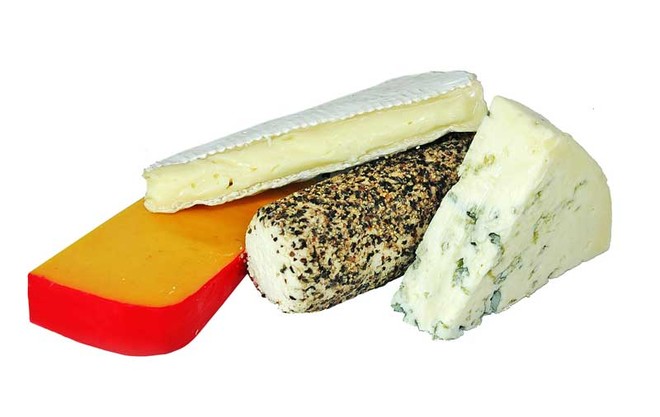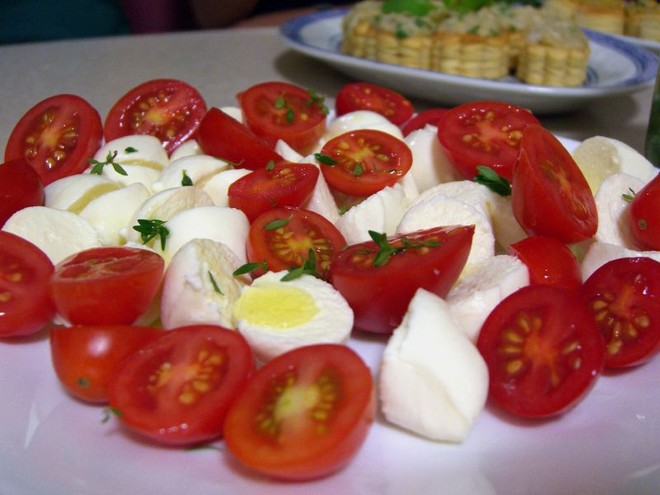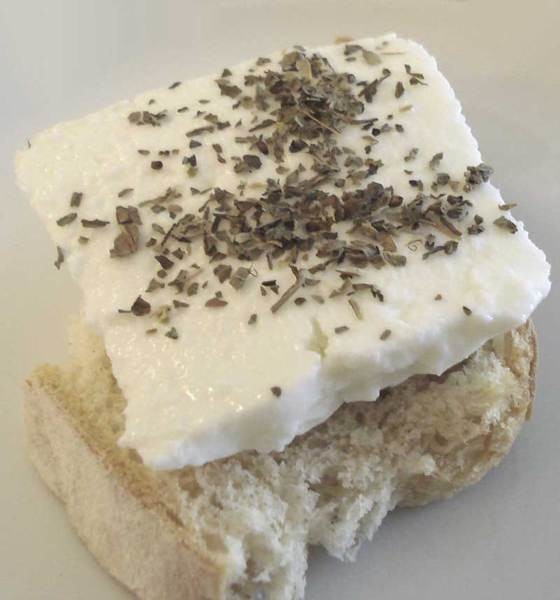Soft and fast Soft cheeseSoft cheeses do not mature for long –from one day to a couple of weeks. The resulting consistency is approximately the same - from classically soft (feta) or elastic (suluguni) to elastic-fibrous (mozzarella) and slightly crumbly (Adyghe). The technological cycle is as follows: milk (sheep, goat, cow, buffalo or milk mix) is mixed with starter, it ferments, curdles, the cheese mass is separated from the whey. Then comes the turn of brine: for most fresh cheeses, brine is the only way to survive. The youngest mozzarella is stored in brine for only one day and is called "giornata", "one-day". For this reason, it is not exported, and you can taste "one-day" only in Italy. Twin cheeses mascarpone and Philadelphia, which are put in cheesecakes and tiramisu, do without brine. The family ties of cheeses extend from France to the Caucasus: cousins and second cousins-cheeses live thousands of kilometers apart. However, the common blood is felt: lavash with fresh herbs, tomatoes and suluguni in a lost mountain village of Georgia resembles a flatbread with feta and the same herbs with tomatoes in a Greek tavern, especially in combination with a young, bold and tannic red wine. Italy The first mention of soft cheeses is found in Pliny the Elder. The main heroine of the family of fresh cheeses on the boot-peninsula is mozzarella.
Soft cheeseSoft cheeses do not mature for long –from one day to a couple of weeks. The resulting consistency is approximately the same - from classically soft (feta) or elastic (suluguni) to elastic-fibrous (mozzarella) and slightly crumbly (Adyghe). The technological cycle is as follows: milk (sheep, goat, cow, buffalo or milk mix) is mixed with starter, it ferments, curdles, the cheese mass is separated from the whey. Then comes the turn of brine: for most fresh cheeses, brine is the only way to survive. The youngest mozzarella is stored in brine for only one day and is called "giornata", "one-day". For this reason, it is not exported, and you can taste "one-day" only in Italy. Twin cheeses mascarpone and Philadelphia, which are put in cheesecakes and tiramisu, do without brine. The family ties of cheeses extend from France to the Caucasus: cousins and second cousins-cheeses live thousands of kilometers apart. However, the common blood is felt: lavash with fresh herbs, tomatoes and suluguni in a lost mountain village of Georgia resembles a flatbread with feta and the same herbs with tomatoes in a Greek tavern, especially in combination with a young, bold and tannic red wine. Italy The first mention of soft cheeses is found in Pliny the Elder. The main heroine of the family of fresh cheeses on the boot-peninsula is mozzarella. The homeland of mozzarella is considered to be the provinces of Lazio andCampania: in the 10th century, this territory turned out to be swampy, so the peasants began to breed hardy and unpretentious buffalo, and make cheese from buffalo milk. To this day, the true "Campagne" mozzarella is mozzarella di bufala. Although there is also regular cow mozzarella - fior di latte, and it is produced in large quantities. In their love for mozzarella, the Italians went so far as to open a mozzarella bar in Rome a couple of years ago, thus creating a new format of catering, akin to our dumpling or pancake houses. The bar offers different types of mozzarella, fortunately in Italy their number reaches a hundred. One of the most prestigious varieties of mozzarella is burrata cheese, more tender and oily. Fresh ricotta also belongs to the group. soft cheese similar to our cottage cheese. Italians call ricotta "the stepdaughter of milk", because it is not made directly from milk, but from whey, which is boiled several times. Ricotta is translated from Italian as "reboiled". It is useful due to its low fat content. Ricotta is made from sheep, cow and buffalo milk. It can be not only fresh (ricotta forte), but also aged and even smoked. CaucasusSoft homemade cheese in the Caucasus is an ancient and revered genre. Their own variations on this theme exist not only in each former Soviet republic of Transcaucasia, but also in each region, city and even a separate village. Generalized pop versions have gained nationwide fame: suluguni and "Adyghe" cheese.
The homeland of mozzarella is considered to be the provinces of Lazio andCampania: in the 10th century, this territory turned out to be swampy, so the peasants began to breed hardy and unpretentious buffalo, and make cheese from buffalo milk. To this day, the true "Campagne" mozzarella is mozzarella di bufala. Although there is also regular cow mozzarella - fior di latte, and it is produced in large quantities. In their love for mozzarella, the Italians went so far as to open a mozzarella bar in Rome a couple of years ago, thus creating a new format of catering, akin to our dumpling or pancake houses. The bar offers different types of mozzarella, fortunately in Italy their number reaches a hundred. One of the most prestigious varieties of mozzarella is burrata cheese, more tender and oily. Fresh ricotta also belongs to the group. soft cheese similar to our cottage cheese. Italians call ricotta "the stepdaughter of milk", because it is not made directly from milk, but from whey, which is boiled several times. Ricotta is translated from Italian as "reboiled". It is useful due to its low fat content. Ricotta is made from sheep, cow and buffalo milk. It can be not only fresh (ricotta forte), but also aged and even smoked. CaucasusSoft homemade cheese in the Caucasus is an ancient and revered genre. Their own variations on this theme exist not only in each former Soviet republic of Transcaucasia, but also in each region, city and even a separate village. Generalized pop versions have gained nationwide fame: suluguni and "Adyghe" cheese. The homeland of suluguni is Georgia.This is a young cheese without a rind, ripening in a solution of table salt. Suluguni comes in different degrees of maturity, but ripening in brine is the main condition for its creation. Adyghe cheese is not kept in brine for a long time, so it does not have the strong saltiness of suluguni, but is tender and bland, which resembles mozzarella. It is made like this: milk heated to 100 ° C is mixed with sour whey and filtered through cheesecloth. An infinite number of similar Caucasian cheeses are produced according to the same principle, each of which has its own local name. Many believe that in essence these cheeses, like Greek feta, are close to Bulgarian feta. However, feta is a pressed cheese. Caucasian soft cheeses are good in salads and appetizers, in pie fillings and fried. But their full flavor is revealed when combined with local products: with lavash cooked in an eastern stone oven, with tomatoes grown under the southern sun, herbs and garlic.
The homeland of suluguni is Georgia.This is a young cheese without a rind, ripening in a solution of table salt. Suluguni comes in different degrees of maturity, but ripening in brine is the main condition for its creation. Adyghe cheese is not kept in brine for a long time, so it does not have the strong saltiness of suluguni, but is tender and bland, which resembles mozzarella. It is made like this: milk heated to 100 ° C is mixed with sour whey and filtered through cheesecloth. An infinite number of similar Caucasian cheeses are produced according to the same principle, each of which has its own local name. Many believe that in essence these cheeses, like Greek feta, are close to Bulgarian feta. However, feta is a pressed cheese. Caucasian soft cheeses are good in salads and appetizers, in pie fillings and fried. But their full flavor is revealed when combined with local products: with lavash cooked in an eastern stone oven, with tomatoes grown under the southern sun, herbs and garlic.

Making Money with Desserts: Success Stories
Evgeniya Polischuk (Fedutinova) instagram:@evgeniyafedutinovavk.com/janeshomebaking– It all started with baking for family and friends. Gradually, I started posting photos of my baked goods on Instagram – and orders started coming in. I made my first custom-made cake on October 13, 2014, and a little earlier I started making macaroons and cupcakes. You could say that the business “found me”, I am very […]

Soups are cold recipes with photos
Cold cucumber soup with yogurt and lemonsorbet from the chef of the restaurant La Taverna Alexander Zhurkin Photo: Getty Images Ingredients: Plain yoghurt – 125 g Cucumber – 150 g Lemon/lime sorbet – 50 g Cocktail shrimp – 24 g Fresh ginger juice – 1 g Lime juice – 5 g Fresh orange juice – 5 g Parsley – 1 g Pink pepper – 1 g Watercress – […]

barbeque kebab
Pork tenderloin in glaze Photo:Dmitry Bayrak/dbstudioPreparation time: 20 minutes + marinating time.Calories: 454 kcal per serving.For 4 servings: 4 pork tenderloins (approximately 300 g each), 1 onion, 2 cloves of garlic, 1 tsp. lemon zest, 1 tsp. lemon juice, a pinch of ground cumin, coriander and turmeric, 1 tbsp. vegetable […]

Pierre Duacan: dietary recipes: Ducane diet
Beetroot soup Photo:Season’S, Luxury Hotels RepresentationYou will need:· Boiled beetroot – 60 g· Fresh cucumbers – 20 g· Red radish – 20 g· Green onions – 10 g· Egg – 1 pc.· Drinking mineral water – 200 g· Salt – 1 gPreparation:· Boil the egg and beetroot.· Grate the cucumbers, radish and part of the beetroot. Put everything […]





